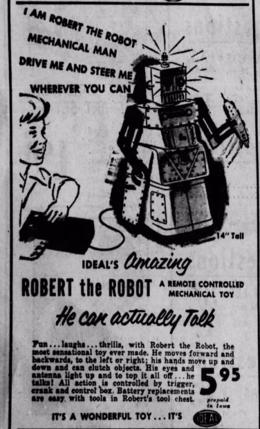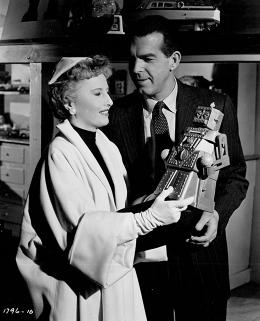"The 1950s Toy Robot Sensation That Time Forgot"
"Before Rosie and R2-D2 became pop culture icons, a humble toy named Robert paved the way.
Robert the Robot, who was a product of the once-mighty Ideal Toy Company, didn't do much, at least compared to the standards set by science fiction at the time. Unlike the helpful humanoids of Isaac Asimov's I, Robot, Robert was just a 14-inch-tall hunk of plastic that could utter a few phrases, wheel around with a tethered remote control, and grip objects in his mechanical arms.
Still, Robert deserves credit for being the first plastic toy robot made in the United States, and the first toy robot to become an American sensation. He was the subject of children's songs, enjoyed a Hollywood film cameo, and was quickly imitated by rival toy makers. He also preceded the industrial robotics boom by several years, capturing people's imagination long before we truly understood what robots could do.

Ta-Ta, Tin
Robert was not the first toy robot of the post-WWII era. That honor, according to Collectors Weekly, goes to Lilliput, a Japanese robot made of tin. After the war, tin lithograph toys were a popular export from American-occupied Japan, and Lilliput spawned plenty of successors.
Instead of tin, Ideal used plastic injection molding—a process that itself rose to prominence during the war. Plastic was cheaper than tin or cast iron, and it allowed American companies like Ideal to produce their own toys instead of importing and reselling them.
"Robert was an answer to this massive amount of tin toys that were coming from Japan," says Justin Pinchot, a Los Angeles-based collector of vintage toy robots and ray guns. "It was really the beginning of the plastic era."
Robert also had a unique aesthetic. As Pinchot points out, no one else was doing large robots with "skirted" lower sections at the time, and the look was quickly duplicated even in Japanese robots such as the "Gang of Five," who remain beloved by toy-robot collectors.
"A lot of these innovations were started here and picked up by Japan, so I think Robert was one of those. I'm sure he inspired a lot of tin stuff," Pinchot says.
The Mechanical Man
How popular was Robert the Robot? While verifiable sales figures are illusive, a September 1955 story in the Portsmouth Times of Portsmouth, Ohio, claimed that Robert was Ideal's biggest hit yet. Demand was so strong that Ideal started licensing T-shirts, flashlights, and other Robert-related merchandise, and when Shillito's Toyland opened in downtown Cincinnati in 1955, a 9-foot-tall Robert greeted customers on the sidewalk, according to the Cincinnati Enquirer.
Read the full article at its source: https://www.fastcompany.com/3066169/robot-revolution/the-toy-robot-sensation-that-time-forgot



Thanks for sharing. Amazing content.
ReplyDeleteRobotics in Education